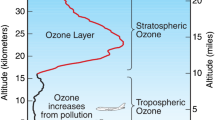Abstract
Crutzen (1974) and Crutzen and Ehhalt (1977) presented two key papers in Ambio that in Ambioexemplify how science first revealed to humankind the potential for damage to our ozone shield in the Anthropocene. Crutzen’s (1974) review is a sweeping summary of the risks to the ozone layer from supersonic aircraft, chlorofluorocarbons, as well as nuclear weapons testing and nuclear war. Crutzen and Ehhalt (1977) described how the nitrous oxide produced from fertilizers could pose another threat to the stability of the stratospheric ozone layer. The two papers are part of a body of influential scientific work that led to the pioneering Montreal Protocol to Protect the Earth’s Ozone Layer to phase out production of chlorofluorocarbons (in 1987), as well as national decisions that slowed or stopped production of supersonic planes (in the 1970s). They remain guideposts today for ongoing international negotiations regarding reducing emissions from fertilizer and limiting nuclear testing.

Similar content being viewed by others
References
Bais, A.F., R.M. Lucas, J.F. Bornman, C.E. Williamson, B. Sulzberger, A.T. Austin, S.R. Wilson, A.L. Andrady, et al. 2018. Environmental effects of ozone depletion, UV radiation and interactions with climate change: UNEP Environmental Effects Assessment Panel, update 2017. Photochemical & Photobiological Sciences 17: 127–179.
Bates, D.R., and P.B. Hays. 1967. Atmospheric nitrous oxide. Planetary and Space Science 15: 189–197.
Birmpili, T. 2018. Montreal Protocol at 30: The governance structure, the evolution, and the Kigali Amendment. Comptes Rendus Geoscience 350: 425–431.
Crutzen, P.J. 1970. The influence of nitrogen oxides on the atmospheric ozone content. Quarterly Journal of the Royal Meteorological Society 96: 320–325.
Crutzen, P.J. 1972. SST’s: A threat to the earth’s ozone shield. Ambio 1: 41–51.
Crutzen, P.J. 1974. Estimates of possible variations in total ozone due to natural causes and human activities. Ambio 3: 201–210.
Crutzen, P.J., and D.H. Ehhalt. 1977. Effects of nitrogen fertilizers and combustion on the stratospheric ozone layer. Ambio 6: 112–117.
Daniel, J.S., E.L. Fleming, R.W. Portmann, G.J.M. Velders, C.H. Jackman, and A.R. Ravishankara. 2010. Options to accelerate ozone recovery: Ozone and climate benefits. Atmospheric Chemistry & Physics 10: 7697–7707.
Dhomse, S.S., W. Feng, S.A. Montzka, R. Hossaini, J. Keeble, J.A. Pyle, J.S. Daniel, and M.P. Chipperfield. 2019. Delay in recovery of the Antarctic ozone hole from unexpected CFC-11 emissions. Nature Communications 10: 1–12.
Dotto, L., and H. Schiff. 1978. The ozone war. New York: Doubleday Books.
Drake, F., and M. Purvis. 2001. The effect of supersonic transports on the global environment: A debate revisited. Science, Technology, & Human Values 26: 501–528.
Fleming, E.L., P.A. Newman, Q. Liang, and J.S. Daniel. 2020. The impact of continuing CFC-11 emissions on stratospheric ozone. Journal of Geophysical Research: Atmospheres 125: e2019JD031849.
Heffer, P., and M. Prud’homme. 2016. Global nitrogen fertilizer demand and supply: trend, current level, and outlook. Proceedings of the 2016 International Nitrogen Initiative Conference, “Solutions to improve nitrogen use efficiency for the world”, 4–8, 1 December 2016, Melbourne, Australia. www.ini2016.com.
Johnston, H. 1971. Reduction of stratospheric ozone by nitrogen oxide catalysts from supersonic transport exhaust. Science 173: 517–522.
Johnston, H.S. 1977. Analysis of the independent variables in the perturbation of stratospheric ozone by nitrogen fertilizers. Journal of Geophysical Research 82: 1767–1772.
Junge, C.E. 1974. Residence time and variability of tropospheric trace gases. Tellus 26: 477–488.
Kanter, D., D.L. Mauzerall, A.R. Ravishankara, J.S. Daniel, R.W. Portmann, P.M. Grabiel, W.R. Moomaw, and J.N. Galloway. 2013. A post-Kyoto partner: Considering the stratospheric ozone regime as a tool to manage nitrous oxide. Proceedings of the National Academy of Sciences of the United States of America 110: 4451–4457.
Mills, M.J., O.B. Toon, R.P. Turco, D.E. Kinnison, and R.R. Garcia. 2008. Massive global ozone loss predicted following regional nuclear conflict. Proceedings of the National Academy of Sciences of the United States of America 105: 5307–5312.
Molina, M.J., and F.S. Rowland. 1974. Stratospheric sink for chlorofluoromethanes: Chlorine atom-catalysed destruction of ozone. Nature 249: 810–812.
Montzka, S.A., G.S. Dutton, P. Yu, E. Ray, R.W. Portmann, J.S. Daniel, L. Kuijpers, B.D. Hall, et al. 2018. An unexpected and persistent increase in global emissions of ozone-depleting CFC-11. Nature 557: 413–417.
Morrisette, P.M. 1989. The evolution of policy responses to stratospheric ozone depletion. Natural Resources Journal 29: 793–820.
Newman, P.A., L.D. Oman, A.R. Douglass, E.L. Fleming, S.M. Frith, M.M. Hurwitz, S.R. Kawa, C.H. Jackman, et al. 2009. What would have happened to the ozone layer if chlorofluorocarbons (CFCs) had not been regulated? Atmospheric Chemistry & Physics 9: 2113–2128.
New York Times. 1978. Most aerosols face a Swedish ban. https://timesmachine.nytimes.com/timesmachine/1978/01/30/110785008.html?pageNumber=17. Accepted 9 Aug 2020.
Rigby, M., S. Park, T. Saito, L.M. Western, A.L. Redington, X. Fang, S. Henne, A.J. Manning, et al. 2019. Increase in CFC-11 emissions from eastern China based on atmospheric observations. Nature 569: 546–550.
Slaper, H., G.J. Velders, J.S. Daniel, F.R. de Gruijl, and J.C. van der Leun. 1996. Estimates of ozone depletion and skin cancer incidence to examine the Vienna Convention achievements. Nature 384: 256–258.
Solomon, S., D.J. Ivy, D. Kinnison, M.J. Mills, R.R. Neely III, and A. Schmidt. 2016. Emergence of healing in the Antarctic ozone layer. Science 353 (6296): 269–274.
UNEP. 2013. Drawing down N2O to protect climate and the ozone layer. A UNEP Synthesis Report. United Nations Environment Programme (UNEP), Nairobi, Kenya.
WMO (World Meteorological Organization). 2018. Scientific Assessment of Ozone Depletion: 2018. Global Ozone Research and Monitoring Project—Report No. 58, 588 pp., Geneva, Switzerland.
Author information
Authors and Affiliations
Corresponding author
Additional information
Publisher's Note
Springer Nature remains neutral with regard to jurisdictional claims in published maps and institutional affiliations.
Rights and permissions
About this article
Cite this article
Solomon, S. Risks to the stratospheric ozone shield in the Anthropocene. Ambio 50, 44–48 (2021). https://doi.org/10.1007/s13280-020-01431-8
Received:
Revised:
Accepted:
Published:
Issue Date:
DOI: https://doi.org/10.1007/s13280-020-01431-8



